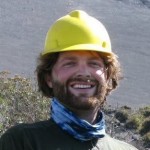
Luke Bowman is a doctoral candidate in the Department of Geological and Mining Engineering and Sciences at Michigan Technological University, where professors Bill Rose and John Gierke have promoted interdisciplinary “social geology” research regarding natural hazards in developing countries through the Peace Corps Masters International program.

Abstract: Despite a long history of volcanic debris flows on the northern flank of San Vicente Volcano, El Salvador, authorities and communities were ill-prepared for the lahars that occurred on Nov. 7–8, 2009. More than 250 people were killed by lahars resulting from shallow landslides, not to mention millions of dollars (US) in damage to houses, agriculture, and infrastructure. After the disaster, significant aid was invested in the region to reduce risk in future disasters. This case study uses the ethnographic tools of qualitative interviews, participant observation, and review of institutional documents to analyze two particular aspects of disaster risk reduction strategies in the town of Verapaz: 1) relocation of at-risk residents led by the Ministry of Housing and Urban Development, and 2) hazard monitoring and emergency management training programs led by Civil Protection, the University of El Salvador, and NGOs. The relocation effort, while effective at reducing physical vulnerability to debris flows, failed to incorporate livelihood, social networks, and cultural ties to homes in their project design and implementation. Since diverse livelihoods are keys to survival, and tightly-knit social networks help families share responsibilities and withstand shocks during hardships, many families returned to the high-risk area or opted not to relocate. Others have adapted using unanticipated strategies to benefit from the resettlement effort. On the other hand, the emergency management training and education programs valued local input, knowledge, and action, which has helped increase awareness and improved the overall capacity to manage emergencies through wide, local participation. The different approaches used in the two risk reduction initiatives reveal important lessons regarding the importance of community participation. Challenges derive from narrow understandings of vulnerability on the part of disaster risk reduction experts, who neglected to consider and understand kin networks and residence patterns that help maintain diverse livelihoods, as well as ensure safety and security. As demonstrated in the 2011 Tropical Depression 12E, effective public engagement and empowerment helped bridge the knowledge, awareness, and preparedness gaps that existed prior to the 2009 disaster.